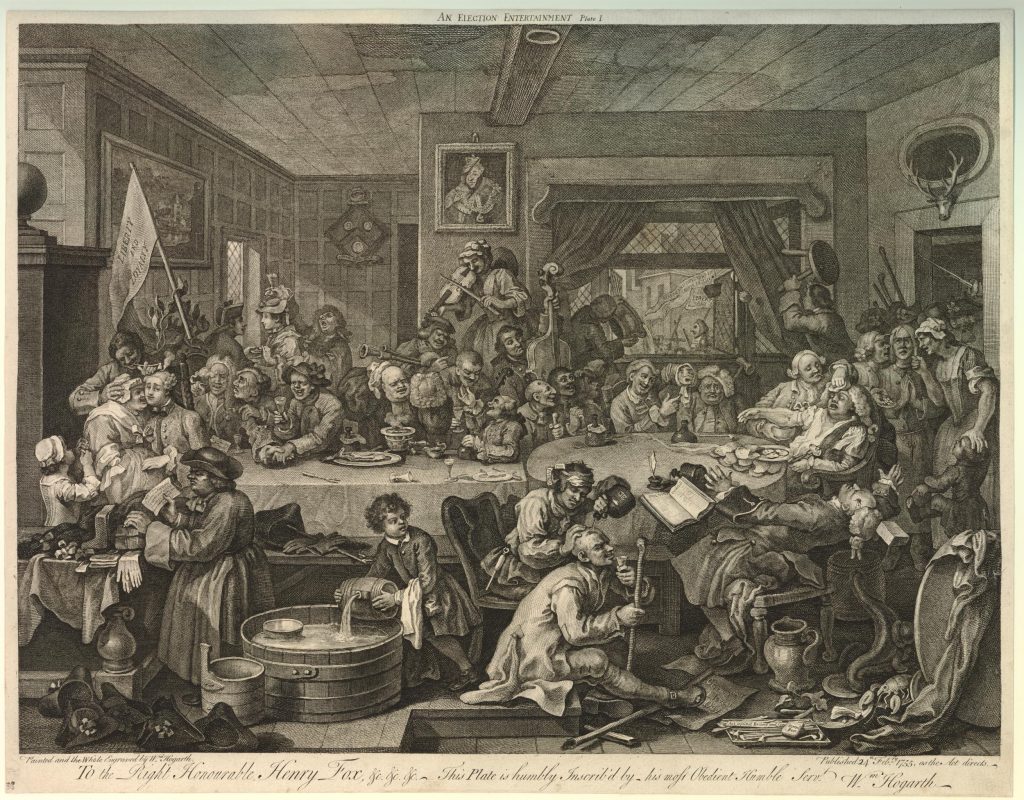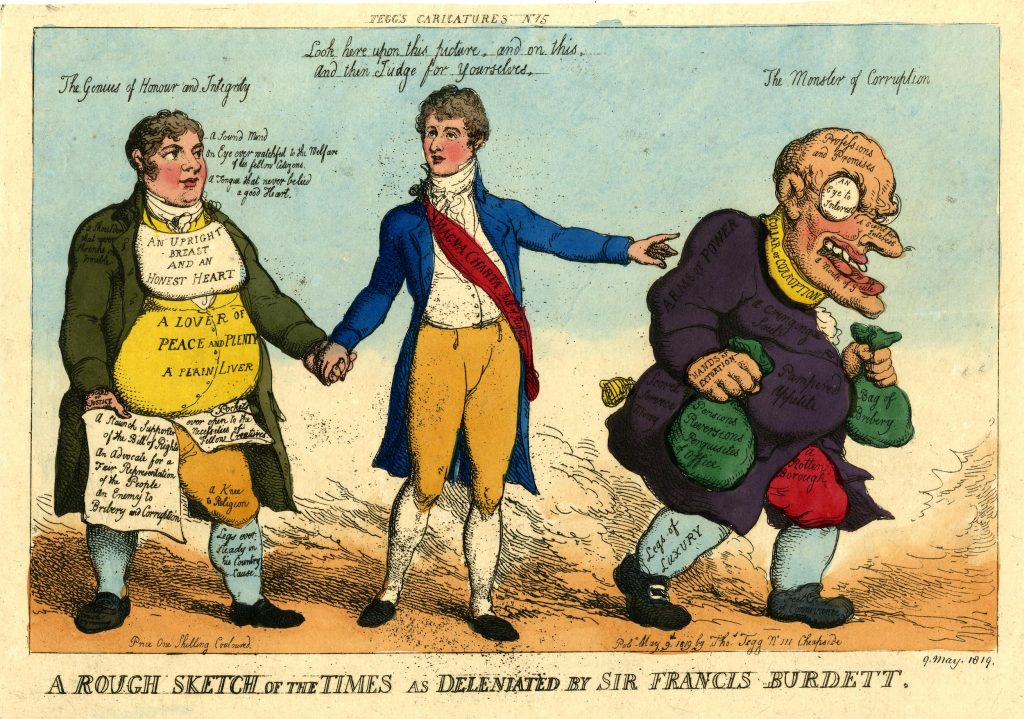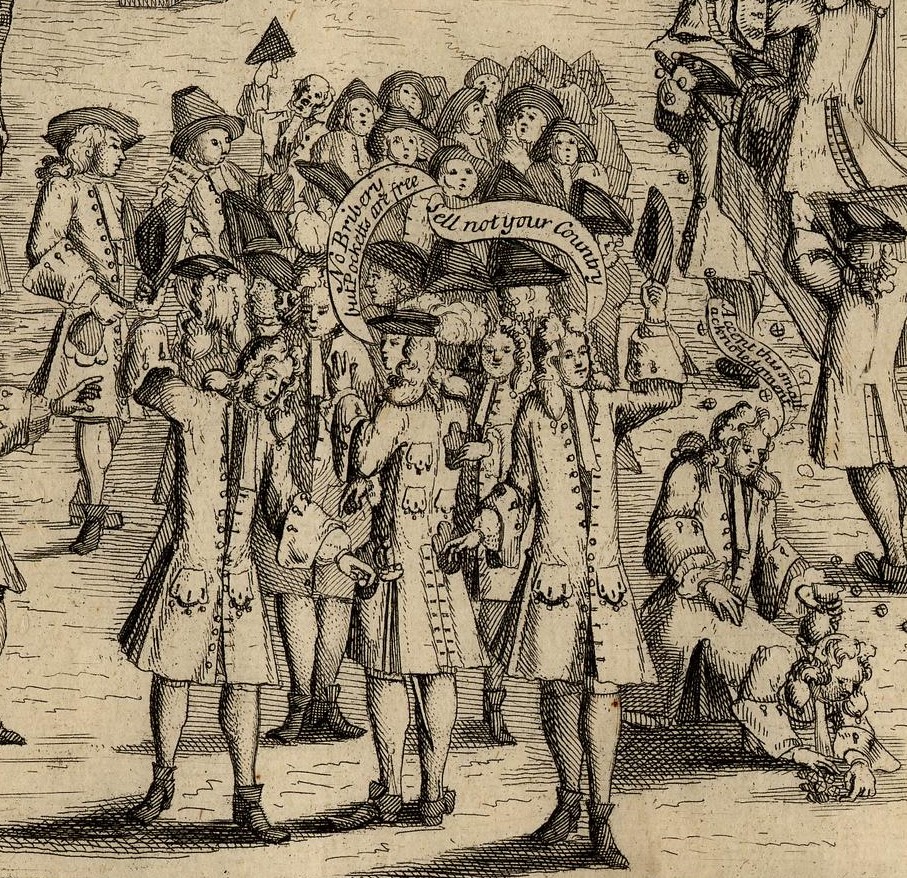Mark Knights discusses attitudes to bribery and patronage in 18th-century elections [30-minute read]
The corruption of electoral politics took two forms: one, of the process of an election itself, and the other, more endemically, of the electoral system as a whole, particularly relating to the prevalence of ‘rotten boroughs’ which enabled the wealthy, the influential and the unscrupulous to buy their way into Parliament. This Feature essay is primarily concerned with the former, though clearly the two were connected, since a corrupt poll fuelled a corrupt system. After experiments in the mid-seventeenth century with reform of the system, it took until 1832 to achieve an interim measure — the so-called Great Reform Act — that dealt with the rotten boroughs in a more systematic way, though who could and should vote remained a contested topic until the early twentieth century, when women were finally enfranchised.
Electoral law was one of the few domains in which corruption was defined and it helped to cement the link between corruption and bribery, terms which are now synonymous but were not so in the pre-modern world. Statutes in the late seventeenth and early eighteenth centuries tried to define when and how far candidates could ‘treat’ or entertain electors. A House of Commons resolution of 2 April 1677 limited expenditure on meat and drink to £10 and declared that ‘any other Present, Gift or Reward, or any Promise, Obligation, or Engagement is by this House to be declared Bribery’.[1] A 1696 act attacked ‘excessive and exorbitant expenses’ and forbade ‘any money, meat, drink, entertainment, or provision, or mak[ing] any present, gift, reward or entertainment’ at election time. The ‘Bribery Act’ of 1729 repeated this prohibition but also imposed an oath on every voter to swear that they had not received ‘any sum or sums of Money, Office, Place or Employment or Gift’ and opened the way to challenge in the courts as well as Parliament, with a penalty of £500 for every offence. Another act in 1809 increased the penalty to £1,000 and extended gifts to include offers of ‘any office, place or employment’.
Yet it is striking that, for all the legislation, these acts had little effect in changing behaviour. A tract of 1854 lamented that all measures had been ‘marvellously baffled, bamboozled and over-reached’.[2] This was in part because there were so many different ways the election process could be corrupted (manipulation of voters, of returning officers, of who was allowed to vote and so on) but also because the incentive, on all sides, to breach the rules for political advantage often made the risk of prosecution or investigation worth taking. As late as the 1850s acts were still being passed to prevent corrupt practices and it was arguably not until the 1883 Corrupt and Illegal Practices Act that a real difference was made.[3]
Electoral bribery was also problematic because the boundary between a gift and hospitality, on the one hand, and a bribe and corruption on the other, was often a blurred one.[4] Gifts were ubiquitous in pre-modern Britain, part of social norms relating to liberality, patronage, friendship, kinship and sociability. Electoral gifts could range from food, drink (plus drinking vessels), and clothes to higher value offers of money, office and donations to community infrastructure, such as buildings and amenities, In 1754, for instance, the inhabitants of Newport billed the candidate £6,000 for paving the town. And the target of the gift might not just be the elector himself: the wife of a voter could then be expected to influence her husband’s polling and a custom of ‘kissing the guinea’ transferred money by a kiss from the candidate or agent. ‘Treating’ a community (often stretching beyond the electorate) at election time was often customary and hence created an expectation that might have political consequences if denied. A 1741 tract note that ‘All Candidates have been so long accustomed to treat &c and the Electors to receive them, that, if any now were to act to the contrary, they would be sure to lose their Election.’[5] Voters in Hull apparently regarded a gift of money as ‘their birthright’.[6] Certainly many anticipated free alcohol. In 1753 Lord Chesterfield deplored ‘the universal drunkenness of the whole people of England which is already begun by way of preface to the approaching elections’.[7] The result was that electioneering was often very expensive, particularly where a contest between candidates increased the need to woo voters. Over £200,000 was spent in the campaign for Yorkshire in 1807.

Political presents could therefore be to some extent legitimised as customary ways of enforcing social ties. Even the government sought to legitimise expenditure. Thus in 1782 Lord North assured the king that the £103,765 spent on elections was ‘not given as bribes. No part of the expense are, in that sense of the word, corruption’.[8] Others thought there were worse forms of corruption (‘making the people drunk with sedition’, for example) than a few drinks of alcohol.[9] What constituted bribery was thus disputed and unclear. Legal advice in 1841 declared that ‘a gift may be innocent if not made for the purpose of influencing, which would be bribery if made for that purpose’ so that the intention behind the gift had to be established.[10] Such ambiguity was often exploited in a partisan way, since it was in the interest of one side to accuse the other of corruption. Numerous election petitions sought to unseat candidates on the grounds that they had offered bribes.
If gifts occupied something of a problematic grey area, clearer threats of corruption came from two sources, the Crown and vested economic interests.
One enduring fear, from the 1670s onwards, was that the Court would use its patronage, influence and public money to corrupt elections. Court, in this sense, was a term of opprobrium for all those subservient to, and benefitting from, Crown and Government. Fear of their influence led to repeated attacks on ‘placemen’, as officials were often called, or of the ‘Court interest’. As early as 1658 a tract warned voters that the ‘unfittest and unworthiest men are commonly the most forward to sue for Place and Offices’.[11] But it was in the 1670s, when it seemed that the earl of Danby was systematically building a ‘Court party’ by bribing MPs, and then again after the revolution of 1688, when Crown patronage was extended significantly by the growth of the fiscal-military state, that concern mounted. In the late seventeenth and early eighteenth century there were frequent calls for ‘place bills’ to ‘incapacitate all Members [from] holding Offices and Preferments’.[12] Some limited measures were enacted but although a place bill passed the Commons in 1739, it was defeated in the Lords, and as a result anxieties about the corrosive influence of the Crown continued well into the nineteenth century, perhaps reaching a peak in the 1780s.

Another source of anxiety was the influence of economic interests, such as the East India Company (EIC). As early as 1701, when one of the directors of the EIC was expelled from the Commons for corruption in four constituencies, there was a fear that the riches of the east were being used to corrupt Parliament. Daniel Defoe warned of ‘Stock-Jobbing Elections’ and Anthony Hammond also warned about the replacement of ‘ancient English Hospitality’ with ‘sordid’ corruption funded by ‘Banks and Funds.’[13] Such fears about corrosive economic interests intensified from the mid eighteenth century onwards, when ‘nabobs’ returned with laden pockets that could (and did) corrupt voters. For example, to influence the Shaftesbury election of 1774 two nabobs, Francis Sykes and Thomas Rumbold, passed money to voters ‘thro a hole in the wall’ at the Red Lion inn by a man dressed as ‘Mr Punch’, a trick designed to allow voters to say they had not been given money by the candidates or their agents.
One effect of corrupt elections was to propel the fortunes of men who claimed to be ‘independent’ of the partisan, royal and economic forces that corroded the representative system. Such ‘patriots’ made a virtue of their antipathy to corrupt practices. In the late eighteenth and early nineteenth century, for example, Sir Francis Burdett was lionised as a champion against corruption and mobilised large crowds to support him.

Yet patriotism was a capacious category, capable of covering many different stripes of candidate, some of whom were far more partisan than their pose of impartiality suggested. Indeed, it was common for electoral propagandists to claim impartiality to draw readers in and be influenced by partisan publications. On the other hand, the development of a provincial press after the lapse of the licensing act in 1695 enabled local periodicals to expose corruption. Thus James Acland attacked it through a serial in Hull which, he thought, was ‘as corrupt a Corporation as exists in this land of Corporate corruption’.[14]
Criticism of electoral corruption also took other cultural forms. In 1715 the first play about electioneering (and corrupt electioneering at that), Susannah Centlivre’s The Gotham Election, was banned from being performed. The play extensively dramatized the corrupt practices of High Church candidates who were portrayed as a danger to religion and the constitution; and the penultimate scene had the rival camps fighting out the contest in a brawl. Such censorship for the depiction of corrupt elections on the stage was not unique. In 1736 Henry Fielding put on Pasquin which attacked corrupt elections as a thinly veiled assault on Robert Walpole’s ministry. The first act was summarised by one character as having the theme ‘Bribe all, Bribe all’. Interestingly both Centlivre’s and Fielding’s plays also attacked ‘petticoat government’, a reminder that corruption was seen in terms of gender inversion as well as money. Fielding published further attacks, to which the government responded with the 1737 Theatre Licensing Act which gave the Lord Chamberlain powers to censor drama, a measure only repealed in 1968.

Cultural critics thus had to turn to other media. Graphic satire became an extensive genre of criticism, though the cost of some prints may have meant they reached fewer people (until the nineteenth century when cheaper images became much more common). One early print critiquing electoral corruption was ‘The Prevailing Candidate, or the ELECTION carried by Bribery and the Devil’ (1722) which shows a voter being bribed by a candidate, with his wife listening to a cleric who proclaims ‘bribery no sin’.[15] The candidate half-emerges from behind a ‘screen’, a term increasingly used to describe Robert Walpole who has thought to have ‘screened’ high profile figures from prosecution after the recent South Sea Bubble scandal (which had also involved corruption). Another image, from 1727, had a similar title and showed several candidates bribing voters in a country town whilst hypocritically declaring against corruption.[16] One voter agrees ‘No Bribery but Pocketts are free’ as the candidate shovels money into it.
William Hogarth’s prints satirising the corruption and popular volatility in the 1754 Oxfordshire election (which cost candidates £27,000) were frequently reproduced. This type of graphic satire proliferated in the second half of the eighteenth century, when electoral corruption was sometimes depicted as a monster, as in this 1807 image where the ‘Genius of Elections’ has ‘Wings of Corruption’ and a ‘Tail of Bribery’, facing an unimpressed John Bull who sits firmly on his padlocked treasure-chest. Anti-corruption was thus not all anger and outrage (though there was plenty of that!); it also had its creative, imaginative, humorous and satirical side.

[1] Commons Journals, ix. 411.
[2] Sir John Eardley-Wilmot, Is Bribery Without a Remedy? (1854), 5.
[3] Kathryn Rix, ‘The Elimination of Corrupt Practices in British Elections? Reassessing the Impact of the 1883 Corrupt Practices Act’, EHR 123:500 (2008), 65-97.
[4] For a more extensive discussion see Knights, Trust and Distrust: Corruption in Office in Britain and its Empire, 1600-1850 (Oxford, 2021).
[5] N. Blanch, The Ax[e] Laid to the Root of the Corrupt Tree (1741), 52.
[6] Thomas Oldfield, An Enitre and Complete History, Political and Personal, of the Boroughs, 3 vols (1792), iii. 254.
[7] The Letters of…the Earl of Chesterfield, ed. Lord Mahon, 4 vols. (1845), iv. 94.
[8] E.N. Williams, The Eighteenth Century Constitution 1688-1815 (Cambridge, 1965), 151.
[9] The Edinburgh Annual Register for 1809 (1811), ii. 288-90.
[10] The Jurist, 3 July 1841.
[11] Some Grave and Weighty Considerations (1658), 3.
[12] John Toland, The Danger of Mercenary Parliaments (1698), 7.
[13] Defoe, The Free-holders Plea against Stock-Jobbing Elections (1701); Anthony Hammond, Considerations upon Corrupt Elections (1701).
[14] The Hull Portfolio (1833), subtitle of volume 3.
[15] Anonymous, The Prevailing Candidate, or the Election carried by Bribery and the Devil, c.1721, etching on paper, 16.3 x 17.1cm, British Museum, 1868,0808.3496.
[16] Anonymous, Ready Mony the prevailing candidate, or the Humours of an election, 1727, etching on paper, 23.7 x 29.8cm, British Museum, 1868,0808.3520.


